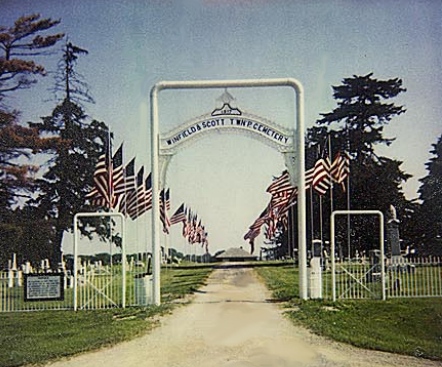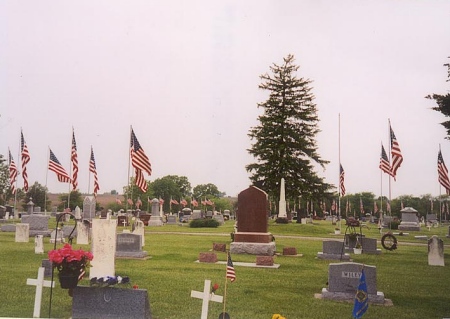
................................................................................................................Photo by Bub Kepper

................................................................................................................Photo by Bub Kepper
Program as presented by Frances Lowe, 2004
My father, Robert Evans, was a township trustee for twenty four years and the cemetery was his pride and joy. So, I guess a little of his interest in it rubbed off on me.
The Winfield Scott Township Cemetery is managed by the township trustees and the Winfield City Council.
On May 21, 1864, one Mary E. Lane deeded a plot of land to the township trustees for $50.00, with the stipulation it was to be used as a cemetery. This Mary Lane was from Fleming County, Kentucky. When I recently discussed it with the County Auditor, we thought there were probably graves on this land already.
According to the records, some of the earliest deeds were dated 1887, but there are earlier markings on a few stones found in the southeast and south center sections.
Of the early stones is a family by the name of Brewington with stones dated 1844, 1853, and 1864. Barrington appears on stones dated 1868, 1877, and 1863. There is a stone marking the grave of Sam Miller that's dated 1854.
Nan Grimmer's great-great-grandmother, Mary Thompson, died in 1860 and is thought to be the first woman buried here, according to Lindy Chrisinger, according to the Davidson family.
The McCulleys, who had donated the land on which the United Presbyterian Church was built, were early settlers just north of town. The dates on their stones are 1857, 1858, and 1865.
Also in the southeast section is the Bashford family. They were early settlers of Winfield and there is a street named for them. This street runs for three blocks north from the water tower. The dates on the Bashford stones are 1864, 1879, and 1893.
The Goodspeeds' stone is the shape of a tree with small log stones on individual graves, dated 1906, 1911, and 1920.
There are several "tree" stones throughout the cemetery. One of these is in the north center section and is inscribed S. E. Kepper. There is a stone tree in the center section with the name Timmer.

In the southeast section are Englands, 1883; Davidsons 1867, 1889, and 1891. The Davidsons were from southeast of Winfield and were ancestors of the Grimmers.
Lief Andrews was the first settler in Old Round Grove Timber in the early 1800s. He was first buried in the timber and placed in the cemetery many years later.
Just west of the main gate, we find Larkins, 1849 and 1859, early settlers from west of town. There are Malones, 1866 and 1868. The Plants, who also lived just west of town, were buried in 1856, 1870, and 1878. Coopers died in 1872 and 1873. Chrisingers were buried in 1871 and 1889. Farrs in 1856 and 1872. Payne in 1860. Deals were buried in 1875 and 1879. The Cooper stone is inscribed: "Of Puritan descent, patriotic, of strong intellect and a devout Christian."
The casket is placed in the ground with the feet to the east, the head to the west. It's said, as the sun rises and sets...is the reason most all stones face east and west.
As near as I can count, there are approximately 2,900 burials in Winfield Scott Township Cemetery, of which approximately 200 are infants.
There are two hundred and thirty-two war veterans. Fifty-nine are Civil War Veterans. Click here for a list of the latter. The Veterans Post of Winfield puts flags on all the graves on Memorial Day. The graves that have a white cross with a poppy are those of WWI Veterans; they number seventy. There are seventy-five WWII Veterans, thirteen from Korea and eight from Viet Nam. There are seven graves for soldiers who served in peace time.
In the northeast section there is a stone with the name John Barr, dated 1898. His epitaph reads: "He was a prisoner of war in the Andersonville prison in the Civil War."
Also in the northeast section is Julius Jensen who was a brick mason and he built his own stone. In time it fell to ruin and now there is only the base and the name Jensen left. I remember it was of white brick.
Continuing in the northeast section, there is a stone with an open bible on the grave of Reverend John Wilson of England. He died at the age of thirty-six.
Another interesting stone is that of E. D. Young. It is of marble and metal with verses on it. There are a few other like this, also, in the cemetery.
The stone of George and Lillie Haight are different as the graves are covered with long marble slabs. Mike Honts tells me these are called ledgers and are indicative of a Dutch background.
Some new stones in this area have real farmstead photos on them.
The Ann Conner stone is another stone tree, dated 1886.
Years ago people bought family plots that would hold ten people. Today, plots that measure four by ten feet sell for $25.00 each. The cost to have a grave dug is $350.00. The cost for cremation is $150.00. Iowa law requires you be buried in a vault. In some cities, people rent a casket, later to be put in a heavy cardboard box and into a vault. This saves the cost of a casket.
Right now we pay $500 per year to have the cemetery mowed in the summer.
As near as I can recall, the gravel roads were put in in the late 30s or early 40s, and I remember my father helping put them in.
In the east center section is a stone of blue marble that was imported from Sweden and quite expensive. It is the stone of Harold Lee and his wife - who are still living.
The oldest person buried here is Carl Lee, who was 101. His grave is across from the Veteran's Monument.
There is Alexander Lee, 1870; his wife, Margaret, 1850; and other Lees, 1872, 1880, and 1884.
Also in the east center section is the Willis stone, 1884; Owens, 1895; and the Rittenhouse stone, dated 1882.
Years ago a man by the name of A. J. Griffin took care of the cemetery, digging and filling all the graves by hand. He mowed with an old reel-type mower and trimmed with a scythe and sickle. Carl Sandquist helped him at times.
In the center section is a stone of the Gambell family. They are not buried here, but their stone is here. They were missionaries from the Presbyterian Church to Alaska. On their way back, after furlough here in the states, their ship hit an iceberg and sank, taking the husband, wife and daughter's lives. The north and east windows of the Presbyterian Church are memorials to the Gambell family. In 1998, on the 100th anniversary of their deaths, the back room of the sanctuary was named the Gambell Memorial Chapel. There is an island named for them in Alaska.
The Hibbets were early residents of Winfield, 1854, 1876, 1879, and 1883 appear on their stones.
Another stone that looks like a tree is Alma Sater's, 1894.
There is a large gray stone of the Freeman family, with dates of 1869 and 1901. Eva Freeman, who was their descendant, owned land east of Winfield and gave her home on North Olive Street to the Senior Woman's Club when she passed away in 1958.
In the center section are people by the name Robbins, 1885 and 1889; John Cutter, 1894; Elizabeth Cutter, 1894; and Carrie Cutter, 1873.
In the north center section, there are the Barriers, 1882 and 1890. Gladys Sewell, 1895, who was one year old. Elizabeth Ross, 1885; and Israel Ross, 1896.
The largest stone is Levi Metzger, in the north center section, near the drive, at the west end. He was a cattle man and farmer northeast of Winfield. Also in this section is the only stone in the cemetery that faces north and south. It is the Ridgeway stone. I asked Walker Evans about it one time and he said, "The Ridgeways were always a little different."
David Bridges was the oldest buried here until 1999. He was 100 years old when he died in 1958. He was the man that brought the mail from the depots to the post office.
Also in the north center, toward the northwest corner, is the stone of George Ott. He died during the depression and there wasn't any money for a stone. In the late 30s, the railroad brought in some small marble chunks to keep the roadbed from washing. The two Ott sons and a friend took a coaster wagon and brought a stone up and put it at their father's grave. Years later, there was a man engraving dates on several stones and when he heard this story, he asked where the stone was. He said, "If the boys went to that much work, the least I can do is engrave the name and date." Which he did. Years later, when the Ott boys mother passed away, her stone was a close match to her husband's.
In the northwest section is the grave of Myer Pavsner. His stone has the Star of David on it. I understand he came to the united States when he was three, the son of Russian Jews. His widow, Mary, still lives here in Winfield.
In the southwest section is the grave of Dwight Shahan, 1957 - 1971. On his tombstone it says, "He loved life, his fellow man and nature, was killed by a drunken driver."
Today a lot of newer stones have pictures of farmsteads, or trucks, or tractors, golfers, some even a portrait of the deceased. Some have the names of their children and wedding dates.
There are two burial sites outside of the cemetery. One is in the timber west of where Terry and Page Kepper Cornick live. Click here for an arial view of this timber location. They were the Hockrietors, early settlers here, related to Briggs. A couple stones from the timber have been moved to the cemetery inscribed Bartholomew Hockrietor, 1870, age 82; and Eliza, 1872, age 60. (Others buried in the Hochreiter or Kepper Cemetery, Scott Township, Henry County, Iowa, Section 9 areWilliam H. Bennett, d. 20 April, 1855 at thirty-seven years of age and his son, John G., who died in 1857 at five years of age. Thomas N. Dodds died the 15th of May, 1857, aged 30 years 11 months. Ervin Gordon died 1857 at twenty-six years of age. William Hale, son of J. P. & M. E. L. Hale, died in 1851 age one month. Mary Elizabeth Hinkle, daughter of A. & S. Hinkle, died 1856 at age fifteen years. Sarah Jane Hoover, wife of G. Hoover, died the 8th of April, 1854, aged thirty-six years, nine months and twenty-five days. Benjamin Shockley died November 5, 1849, aged sixty-nine and his wife, Salley, died in 1847 at the age of sixty. Caroline Hochreiter, daughter of B. & E. Hochreiter died in infancy.) Also, northwest of Winfield, on the old Lloyd Howser farm, where Melvin Huston now lives, is the grave of Adam Richie. After he died his wife took their children and joined a wagon train on the Oregon Trail and settled in Oregon.
In the northeast section the stone of Phyllis (Chrisinger) Volkens says: "She wasn't always right, but she was never wrong."
I wish I could have garnered information on every stone in the cemetery, but not all who lie beneath the stones have relatives to tell interesting stories of the lives they led.